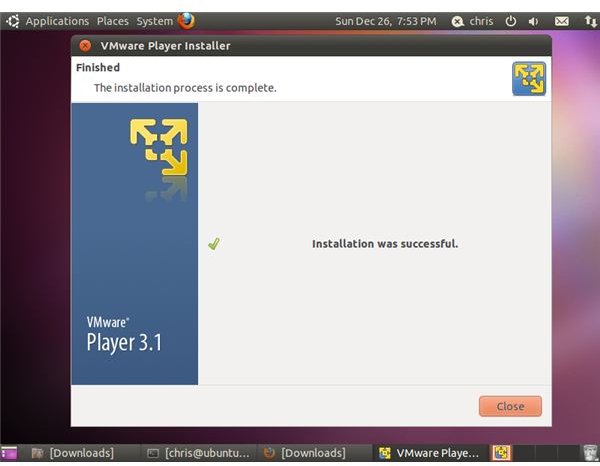Installing and Configuring VMware Player for Linux
Downloading
VMware Player for Linux is a free download from VMware’s website, but you have to sign up for a free VMware account first. Download VMware Player from the official website here. Click the “Download” link to the right of “VMware Player for 32-bit Linux” or “VMware Player for 64-bit Linux” after signing up for an account.
If you don’t know what version of Linux you’re running, click “Applications,” click “Accessories,” click “Terminal,” type “uname -a” into the terminal window and press “Enter.” If the output contains “i686” or similar, you’re using a 32-bit version of Linux. If the output contains “x86_64,” you’re using a 64-bit version of Linux.
Installing
The VMware Player for Linux installer comes in “.bundle” format, which is actually just a normal shell script with a different file extension. You can install it by running the shell script:
- Open a terminal by clicking “Applications,” “Accessories” and “Terminal.”
- Navigate to the directory containing the downloaded .bundle file by typing “cd Downloads” and pressing “Enter.” Replacing “Downloads” with the name of the folder you downloaded the .bundle file to.
- Run the installer by typing “sudo sh VMw” and pressing “Tab” to automatically file the file name, then pressing “Enter.” If you’re not using Ubuntu Linux, type “su -c “s file.bundle””, replacing “file.bundle with the name other downloaded file, and pressing “Enter.”
- Type your password at the password prompt which appears and press “Enter.”
- Follow the instructions on your screen in the graphical VMware installer which appears.
Screenshot: Chris Hoffman / VMware Player Installer on Ubuntu
Launching and Configuring
Open VMware Player for Linux once it’s installed by clicking “Applications,” “System Tools” and “VMware Player.” Click “Accept” after reading the end user license agreement.
Configure VMware Player settings by clicking “File” and “Player Preferences.” You can customize what happens when you close virtual machines, when to check for and download software updates or components and whether to help improve VMware Player by sending usage data back to VMware. VMware Player downloads VMware Tools installers for each operating system when you need them unless you click “Download All Components Now” in this window.
Installing Virtual Machines

If you want to install an operating system such as Windows or another distribution of Linux, click “File” and “Create a New Virtual Machine.” You can install the operating system from an installer CD or DVD you insert into the computer or from an ISO image file of the installer disc you select.
VMware Player for Linux detects the operating system present in the disc image and also asks you to confirm the operating system you’re installing. VMware creates the virtual machine with default setting appropriate to that operating system. If you select a popular operating system such as Windows, VMware installs that operating system with its Easy Install feature. Easy Install automatically completes the installation steps, reducing the amount of user interaction required.
While it isn’t officially supported, you can even install Mac OS X in VMware Player. Check out our guide here.
Screenshot: Chris Hoffman / VMware Player on Ubuntu
Configuring Virtual Machines
After the operating system is installed, you can launch it by double-clicking it in the VMware Player window or configure its virtual hardware devices and other settings by right-clicking it in the VMware Player window and clicking “Virtual Machine Settings.” You can’t edit hardware devices for a virtual machine that’s suspended to disk, so perform a normal “Shut Down” of the guest operating system if you want to change its settings.
Be sure to install VMware Tools on each guest operating system you install by clicking the “Virtual Machine” menu, clicking “Install VMware Tools” and following the instructions on your screen. VMware tools provides optimized drivers which speed up guest operating systems and better integrate them with the host operating system.
Virtual Appliances
Download virtual appliances which run in VMware Player for Linux by clicking “FIle,” “Download a Virtual Appliance” and browsing through the list of appliances on VMware’s website. Virtual appliances range from virtualized servers and dedicated browsing operating systems to pre-configured Linux distributions.
